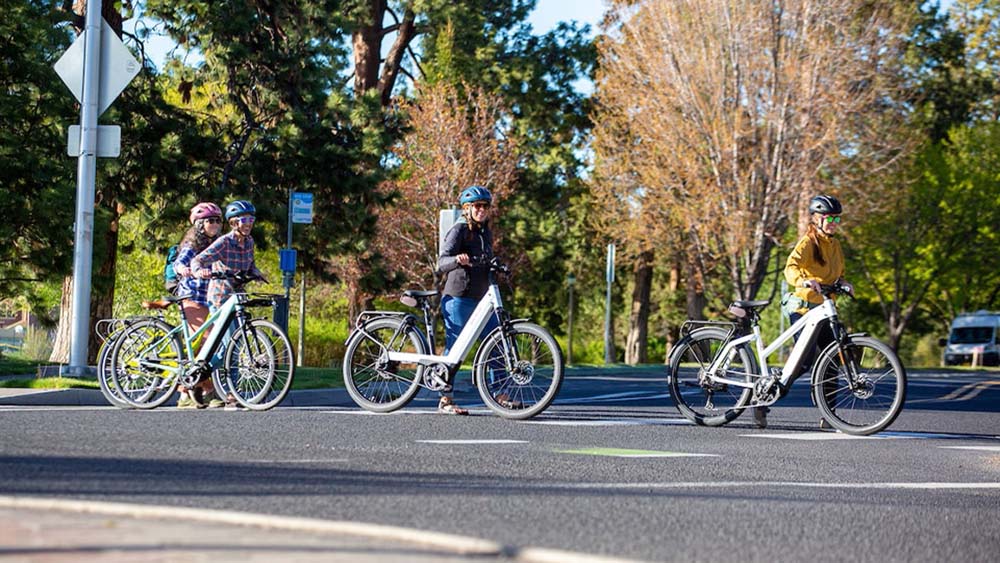Are Electric Bikes Allowed on Sidewalks: Navigating the Regulations
Introduction
In recent years, electric bikes (e-bikes) have gained immense popularity as a sustainable and efficient mode of transportation. With their electric motors, they offer an eco-friendly alternative to traditional bicycles, making them an appealing choice for commuters and enthusiasts alike. However, as e-bike usage surges, questions about where they are allowed to ride, particularly on sidewalks, have arisen. In this article, we will explore the regulations surrounding ebikes on sidewalks, offering clarity to riders and pedestrians alike.

Understanding E-Bikes
Before delving into the rules and regulations, it’s important to clarify what electric bikes are. E-bikes come in various classes, with Class 1 and Class 2 being the most common:
Class 1 E-Bikes: These are pedal-assist e-bikes, meaning they require the rider to pedal, and the electric motor provides assistance. They do not have a throttle.
Class 2 E-Bikes: These e-bikes are equipped with a throttle, allowing the rider to control the speed without pedaling.
Are E-Bikes Allowed on Sidewalks?
The permissibility of riding e-bikes on sidewalks largely depends on local regulations, as rules can vary from one jurisdiction to another. However, there are some general guidelines to keep in mind:
1. Local Regulations Prevail
Local governments, cities, and municipalities have the authority to set rules regarding e-bike usage on sidewalks. Some areas permit e-bikes on sidewalks, while others restrict them to roads or bike lanes.
2. Class of E-Bike Matters
The class of your e-bike can influence where you are allowed to ride:
Class 1 E-Bikes: In many places, Class 1 e-bikes are more likely to be permitted on sidewalks, as they require pedaling and are considered similar to traditional bicycles.
Class 2 E-Bikes: These e-bikes, with their throttle control, may be less likely to be allowed on sidewalks due to safety concerns, as they can achieve higher speeds without pedaling.
3. Pedestrian Safety Is Key
In areas where e-bikes are permitted on sidewalks, it is crucial to prioritize pedestrian safety. Riders should exercise caution, reduce speed, and yield to pedestrians at all times.
Check Local Laws
To ensure compliance with local regulations, it is advisable to check with your city or municipality regarding the specific rules governing e-bike use on sidewalks. This proactive approach can help you avoid potential fines and contribute to safer urban mobility.

Top Tips for Maximizing Your E-Bike Experience
Electric bikes (e-bikes) have revolutionized the world of cycling, offering an effortless and eco-friendly way to get around. Whether you’re a seasoned e-bike enthusiast or just getting started, these tips will help you make the most of your e-bike experience.
1. Understand Your E-Bike Class
E-bikes come in different classes, each with its own set of rules and capabilities. Understanding your e-bike’s class is essential:
Class 1: These e-bikes provide pedal-assist assistance and do not have a throttle. They are often treated like traditional bicycles in terms of regulations.
Class 2: Class 2 e-bikes come with a throttle in addition to pedal-assist. Regulations for these e-bikes may vary, so be aware of local laws.
2. Safety First
Wear a Helmet: Safety should always be your top priority. Wear a properly fitted helmet to protect your head in case of accidents.
Use Lights: Equip your e-bike with lights for visibility, especially if you ride in low-light conditions or at night.
Follow Traffic Rules: Obey traffic signals, signs, and road rules. E-bikes are often subject to the same rules as regular bicycles.
3. Maintain Your E-Bike
Regular Checkups: Keep your e-bike in good condition by performing regular maintenance checks. Ensure the brakes, tires, and electrical components are functioning properly.
Battery Care: Properly charge and store your battery to prolong its life. Avoid extreme temperatures and use the manufacturer-recommended charger.
Keep it Clean: Clean your e-bike regularly to prevent dirt and grime from affecting its performance.
4. Learn Your Range
Understanding your e-bike’s range is crucial for planning your rides. Factors like terrain, rider weight, and assist level can affect how far you can travel on a single charge. Familiarize yourself with your e-bike’s range and plan your journeys accordingly.

5. Optimize Assist Levels
Most e-bikes offer multiple assist levels. Experiment with these settings to find the right balance between speed, battery life, and effort. Lower assist levels conserve battery power, while higher levels provide more assistance but drain the battery faster.
6. Lock it Up Securely
Invest in a high-quality lock to secure your e-bike when you’re not riding. E-bikes can be attractive targets for thieves due to their value, so take precautions to protect your investment.
7. Explore New Routes
One of the joys of owning an e-bike is the ability to explore new routes and destinations. Venture out and discover scenic paths, bike trails, and hidden gems in your area.
8. Join the E-Bike Community
Consider joining e-bike forums or local riding groups. Connecting with fellow e-bike enthusiasts can provide valuable insights, tips, and a sense of camaraderie.
9. Stay Informed
Keep yourself updated on e-bike regulations in your area, as they can vary. Laws regarding speed limits, helmet requirements, and where you can ride may change, so stay informed to avoid legal issues.
10. Have Fun and Share the Joy
Lastly, don’t forget to enjoy the ride! E-bikes offer a fantastic way to explore, commute, and stay active. Share your enthusiasm with friends and family to spread the joy of e-biking.
Conclusion
In the ever-evolving landscape of e-bike regulations, the permissibility of riding on sidewalks is subject to local laws and the class of e-bike in use. While some areas allow e-bikes on sidewalks, others may prohibit them to maintain pedestrian safety. To avoid legal complications and ensure a harmonious coexistence with pedestrians, riders should be diligent in researching and adhering to local regulations. Ultimately, fostering a culture of responsible e-bike usage can contribute to safer and more enjoyable urban environments for all.
Remember, for the most accurate and up-to-date information on e-bike regulations in your area, consult your local authorities.
FAQs:
- Are electric bikes allowed on all sidewalks?
- The legality of electric bikes on sidewalks depends on local legislation. It is crucial to familiarize yourself with the specific rules in your area.
- Where else can electric bikes be ridden if not allowed on sidewalks?
- Alternatives include bike lanes, designated cycling paths, or dedicated electric bike routes. Always check local regulations for guidance.
- How can electric bike riders ensure pedestrian safety on sidewalks?
- Adapting your riding style to accommodate pedestrian traffic, maintaining a reasonable speed, and respecting pedestrians’ right of way are crucial.
- Can electric bike riders influence regulations and infrastructure?
- Engaging in open dialogue, advocacy, and responsible riding can shape the future of electric bike regulations and infrastructure.
- Why are electric bikes gaining popularity?
- Electric bikes offer a practical and eco-friendly alternative for commuting, combining convenience and sustainability.
Sign up for our email list and be entered to win a Pioneer Electric Bike
 Shuangye ebike
Shuangye ebike
